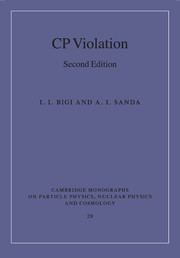Book contents
- Frontmatter
- Contents
- Preface to the second edition
- Preface to the first edition
- Part I Basics of CP violation
- Part II Theory and experiments
- Part III Looking beyond the Standard Model
- 16 Quest for CP violation in the neutrino sector
- 17 Possible corrections to the KM ansatz: right-handed currents and non-minimal Higgs dynamics
- 18 CP violation without non-perturbative dynamics – top quarks and charged leptons
- 19 SUSY-providing shelter for Higgs dynamics
- 20 Minimal flavour violation and extra dimensions
- 21 Baryogenesis in the universe
- Part IV Summary
- References
- Index
19 - SUSY-providing shelter for Higgs dynamics
Published online by Cambridge University Press: 10 March 2010
- Frontmatter
- Contents
- Preface to the second edition
- Preface to the first edition
- Part I Basics of CP violation
- Part II Theory and experiments
- Part III Looking beyond the Standard Model
- 16 Quest for CP violation in the neutrino sector
- 17 Possible corrections to the KM ansatz: right-handed currents and non-minimal Higgs dynamics
- 18 CP violation without non-perturbative dynamics – top quarks and charged leptons
- 19 SUSY-providing shelter for Higgs dynamics
- 20 Minimal flavour violation and extra dimensions
- 21 Baryogenesis in the universe
- Part IV Summary
- References
- Index
Summary
Supersymmetry – a theory with a great future in its past?
Our discussion of CP violation based on left–right models was driven by two complementary goals, namely to implement CPnon-invariance in a spontaneous fashion and to have the dynamics subjected to a higher degree of symmetry. The motivation for analysing non-minimal Higgs dynamics was much less profound: since no rationale more compelling than simplicity has emerged for limiting ourselves to minimal Higgs dynamics, we should be obliged to look beyond a minimalistic version – even if it served only as an imagination stretcher. The Higgs sector is quite commonly perceived as the product of some effective, yet ultimately unsatisfactory, theoretical engineering. Two types of scenario have been suggested to provide a more appealing framework.
(A): Higgs fields are composites rather than elementary and represent an effective description of some unknown underlying dynamics. Technicolour models are one implementation of this scenario that used to be quite popular. Few definite statements can be made in such models. Yet it would be miraculous if a minimal Higgs sector emerged, and extra sources of CP violation are likely to surface following the classification given in Chapter 17.
(B): There is one very elegant theoretical scheme that provides a natural habitat for scalars – namely supersymmetry (SUSY). Since we consider it so attractive, we will describe and analyse this scenario explicitly.
At the same time we note that over the last few years there have been two developments of great significance in this context.
- Type
- Chapter
- Information
- CP Violation , pp. 412 - 435Publisher: Cambridge University PressPrint publication year: 2009

